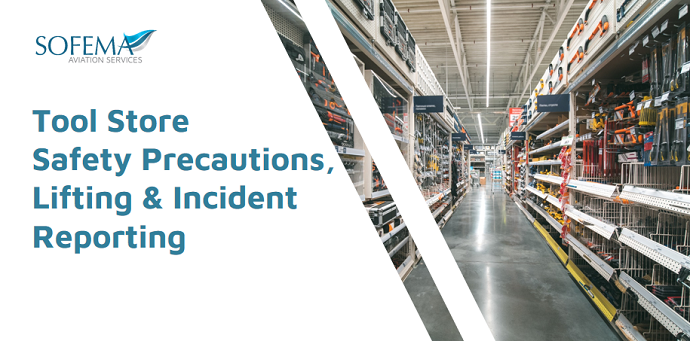Best Practice Considerations for Safe Handling of Tooling and Equipment within the Tool Store Environment
Sofema Aviation Services (SAS) www.sassofia.com considers the best practice to ensure safety in the workplace.
Take Note of the following General Precautions:
- Ensure you have adequate lighting.
- Never carry a tool by the electrical cord or hose.
- Never pull or yank the electrical cord or the hose to disconnect it from the receptacle.
- Keep electrical cords and hoses away from heat, oil, and sharp edges.
- The work area should be free of tripping hazards, do not work in slippery conditions. Wear non-slip leather shoes or boots.
- Avoid awkward positions where possible. Do not operate power tooling within arm’s reach of other employees.
- Know the tools’ proper application and limitations.
- Make sure that the tool is in good condition, the battery is firmly in place.
- For Electrical Corded Tools, make sure the Electrical Cord is not frayed, and that the tool is electrically grounded.
Note – Extension cords should always be grounded.
- Always disconnect tools when not using them, before servicing and cleaning them, and when changing accessories such as blades, bits, and cutters.
- Avoid accidental starting. Do not hold fingers on the switch button while carrying a plugged-in tool.
- Maintain tools with care; keep them sharp and clean for best performance.
- Follow instructions in the user’s manual for lubricating and changing accessories.
- Be sure to keep a good footing and maintain a good balance when operating power tools.
- Wear proper apparel for the task. Loose clothing, ties, or jewellery can become caught in moving parts.
- Remove all damaged portable electric tools from use and tag them: “Do Not Use.”
Lifting of Tooling & Equipment
Lifting heavy items is one of the leading causes of injury in the workplace. Bending, followed by twisting and turning, were the more commonly cited movements that caused back injuries. Strains and sprains from lifting loads improperly or from carrying loads that are either too large or too heavy are common hazards associated with manually moving materials.
Using Smart Practice
When employees use smart lifting practices, they are less likely to suffer from back sprains, muscle pulls, wrist injuries, elbow injuries, spinal injuries, and other injuries caused by lifting heavy objects.
As a general rule – Minimize reaching, bend at the knees, not the hips.
Do not lift or carry things you don’t feel comfortable with, no matter how light the load, get help when needed.
Lifting
- Get as close to the load as possible.
- Try to keep your elbows and arms close to your body.
- Keep your back straight during the lift by tightening the stomach muscles, bending at the knees, keeping the load close and cantered in front of you, and looking up and ahead.
- Get a good handhold and do not twist while lifting.
- Do not jerk; use a smooth motion while lifting.
- If the load is too heavy to allow this, find someone to help you with the lift.
Carrying
- Do not twist or turn the body; instead, move your feet to turn. Your hips, shoulders, toes, and knees should stay facing the same direction.
- Keep the load as close to your body as possible with your elbows close to your sides. If you feel fatigued, set the load down and rest for a few minutes.
- Don’t let yourself get so fatigued that you cannot perform proper setting down and lifting technique for your rest.
Setting Down
- Set the load down in the same way you picked it up, but in the reverse order.
- Bend at the knees, not the hips.
- Keep your head up, your stomach muscles tight, and do not twist your body.
- Keep the load as close to the body as possible.
- Wait until the load is secure to release your handhold.
The Need for Incident Reporting When There is No Injury!
Effective use of voluntary reporting systems exposes potential risks including hazards where there is deemed to be a potential for Injury.
In general, such reporting system makes it possible to take preventive measures before injuries, and in this way, it is able to promotes the overall safety performance of the personnel.
Next Steps
Follow this link to our Library to find & Download related documents for Free.
Sofema Aviation Services provides the following 1-day training course covering the essential areas of the Part 145 Tooling Store
Please see the following link or email team@sassofia.com
Part 145 Stores Tooling Control, Inspection Procedures & Best Practice – 1 Day
Tags:
aviation, EASA Part 145, EASA Part 145 Stores, SAS blogs, Tooling Control, Part 145 Tooling Store, Aviation Tooling Store, Aircraft Tooling, Tool Store Safety Precautions, Tool Store Environment




